Welcome to a new issue of the Journal of Runic Studies, the premier Malkioni publication for studies into the nature of Glorantha. If you haven’t subscribed yet, please consult with the spirit bound to the appropriate electronic page.
God Learner Sorcery
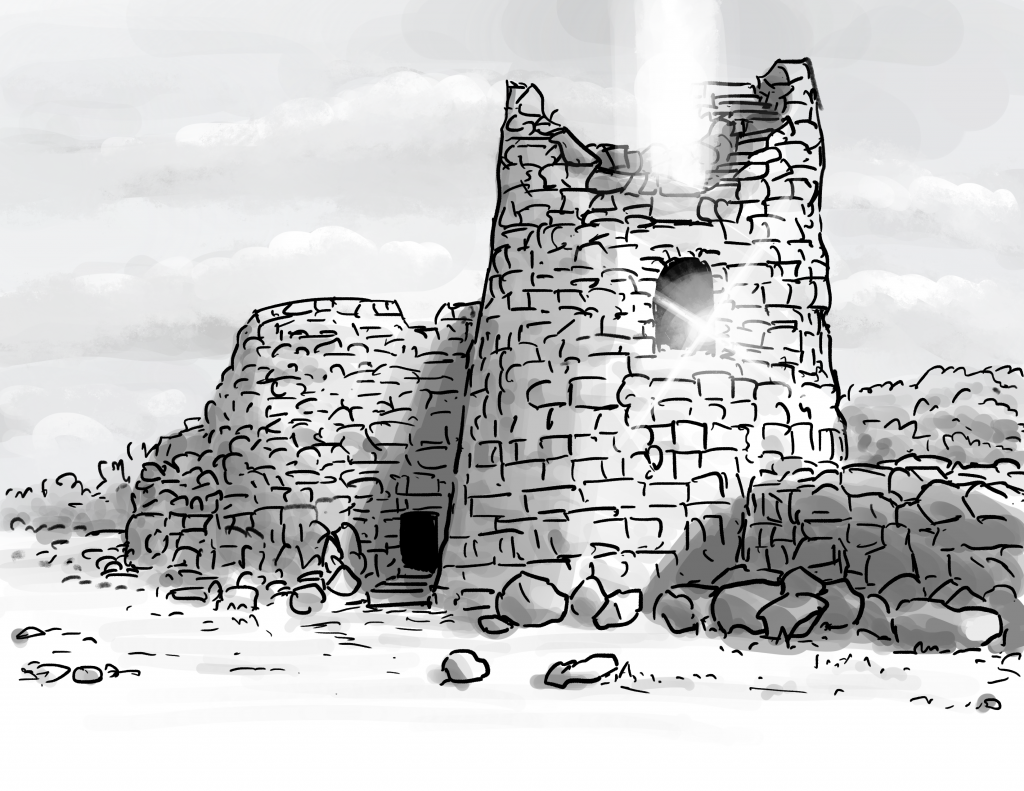
Here is what us God Learners were up to this week.
A Short Detour
My first Jonstown Compendium contribution is finally out!
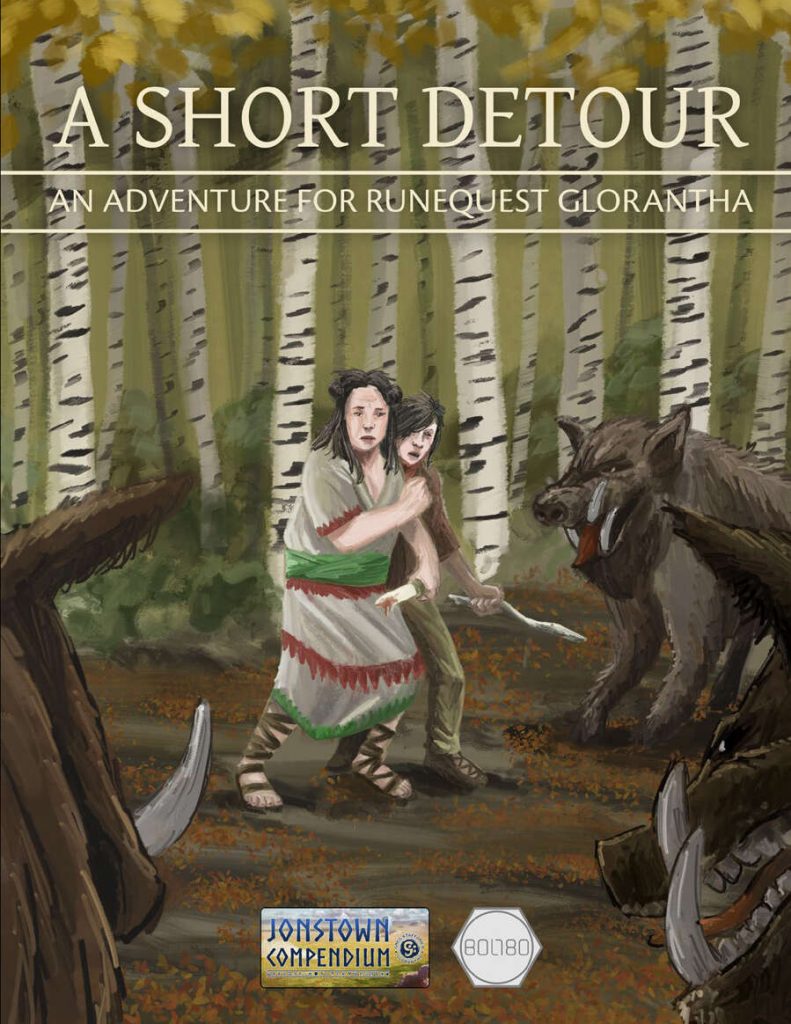
When the adventurers stumble upon a mother and her son being attacked by wild boars, they are thrown into a tricky situation in which multiple powerful factions are on a collision course. What will your players do when they can decide who lives and who dies?
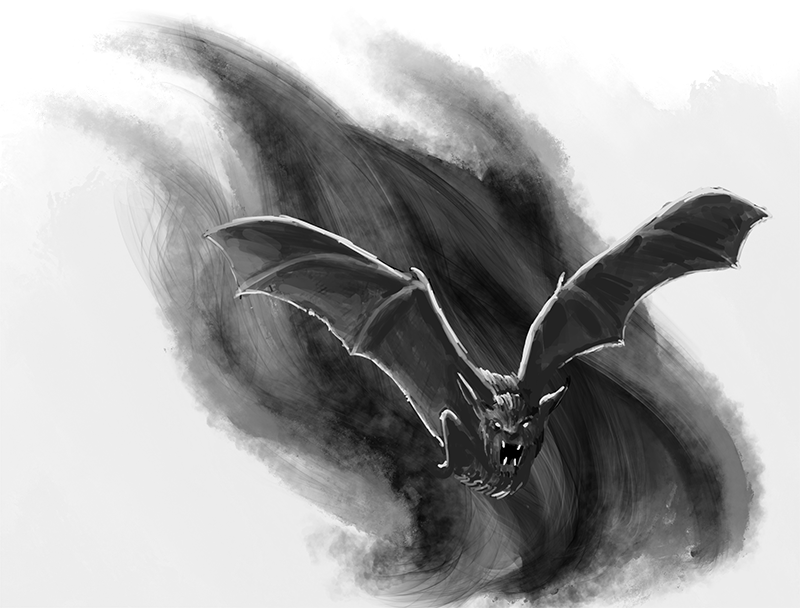
A Short Detour is a straightforward adventure for RuneQuest Glorantha that will take about one big or two short sessions of play. It can be placed anywhere around Sartar, with the text assuming that your campaign is based in or near Colymar lands.
In addition to the adventure, A Short Detour provides an insightful look at the nature of Chaos, with rules for Chaotic corruption.
Of course you should buy the book because it’s great (hopefully)… but if you want to support the God Learners newsletter, blog, and podcast, then you can buy the book to make me think it’s great, and encourage me to continue the other things too!
Characteristic Rolls vs Skill Rolls
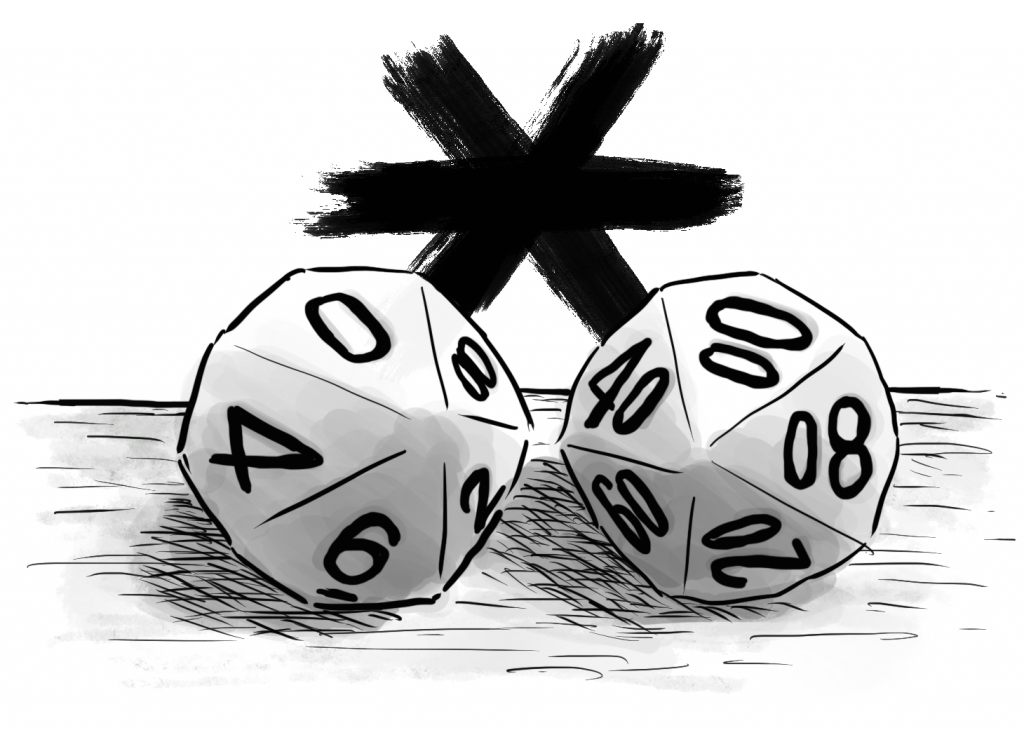
I also wrote a new Runic Rants column this week on one of my pet peeves with the Chaosium’s system:
It’s kind of funny: BRP games like Call of Cthulhu or RuneQuest are among my all time favourite RPGs, but BRP itself is not even close to my top 5 systems. One of the reasons for this is the split between characteristics and skills, which don’t interact much with each other. I’m a kid of the 90s: characteristics and skills are meant to be added together, damn it!
Anyway, this split means that the gamemaster needs to decide when to ask for characteristic rolls, when to ask for skill rolls, and what to do when both could apply. Here are some thoughts.
You can read my advice on dealing with characteristic rolls here.
Chaosium News

Here are this week’s Chaosium news!
New Gamemaster Month is Wrapping Up

New Gamemaster Month has posted their final lesson about running your first game. Here’s the one for RuneQuest. You can still catch up with all the previous articles!
The First Sold Copy of Dungeons & Dragons
Most of you might already know the story, but it came up again recently so it’s always good to repeat it: Greg Stafford owned the first copy ever sold of D&D.
Here’s what happened… Greg and a buddy had been working in Lake Geneva WI area as itinerant belt buckle salesmen (“Real hippy job. I’d take buckles, hitch hike around and sell them to shops, etc.”)
It was Greg’s buddy who met Gary Gygax in a Lake Geneva print shop one day in early 1974: Greg by then was back in the Bay Area, working on his own first game ‘White Bear & Red Moon’, which was eventually published the following year by his new game company The Chaosium.
The Chaosium Twitter account has the rest of the story, plus some links.
Progress on the Fantasy Grounds RuneQuest Module
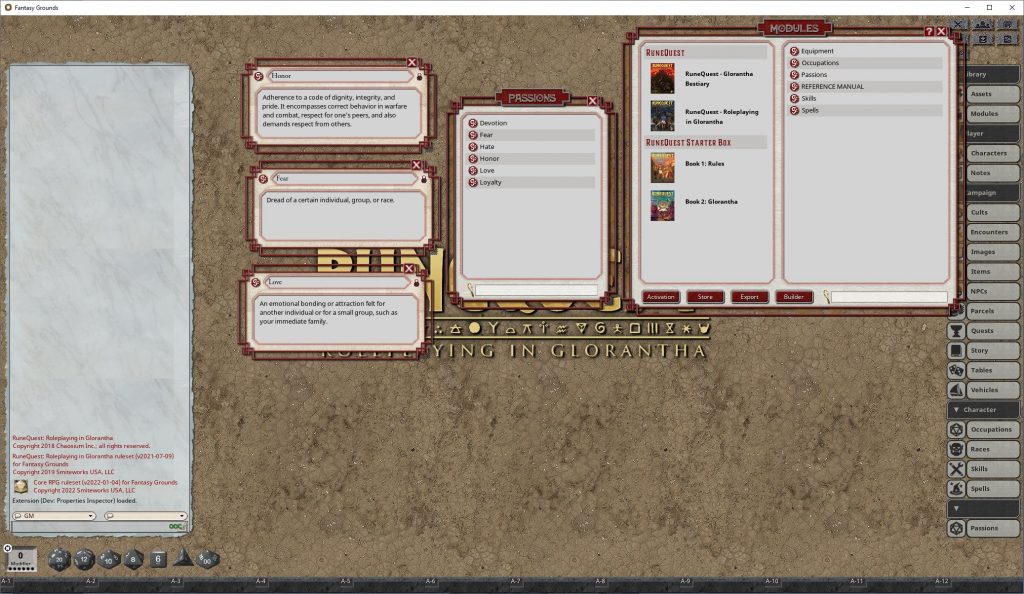
It had been a while since we heard about this, but it looks like work is still going on. Details on Passions are now accessible in the VTT interface.
Jonstown Compendium

The Jonstown Compendium is Chaosium’s community content program for all Gloranthan games, hosted on DriveThruRPG. Disclaimer: all the relevant links are affiliate links that hopefully will let us cover some of the hosting and maintenance costs for the website and podcast! Thanks for using them!
Blue Moon Plateau Area Map

Here is another Mikael Mansen map! This time it’s about the Blue Moon Plateau, up in Peloria.
Jeff’s Notes

Jeff Richard, the current mastermind on everything Gloranthan at Chaosium, is often posting notes and thoughts on the RuneQuest Facebook group. Here’s our curated list from the past week. A partial archive of these sources is compiled on the Well of Daliath.
About the Grazelands
A few notes about the Grazelands:
Let’s keep in mind quick how the Grazeland functions in the present age (rather than how the Yelm cult likes to tell stories about the good old days).
There are about 40,000 people living in the Grazelands, divided into three groups: agriculturalists, horse herders, and townsfolk. All land is “owned” by the Feathered Horse Queen who resolves all disputes between the groups, interacts with outsiders, and unites the nation.
Here’s the Feathered Horse Queen:
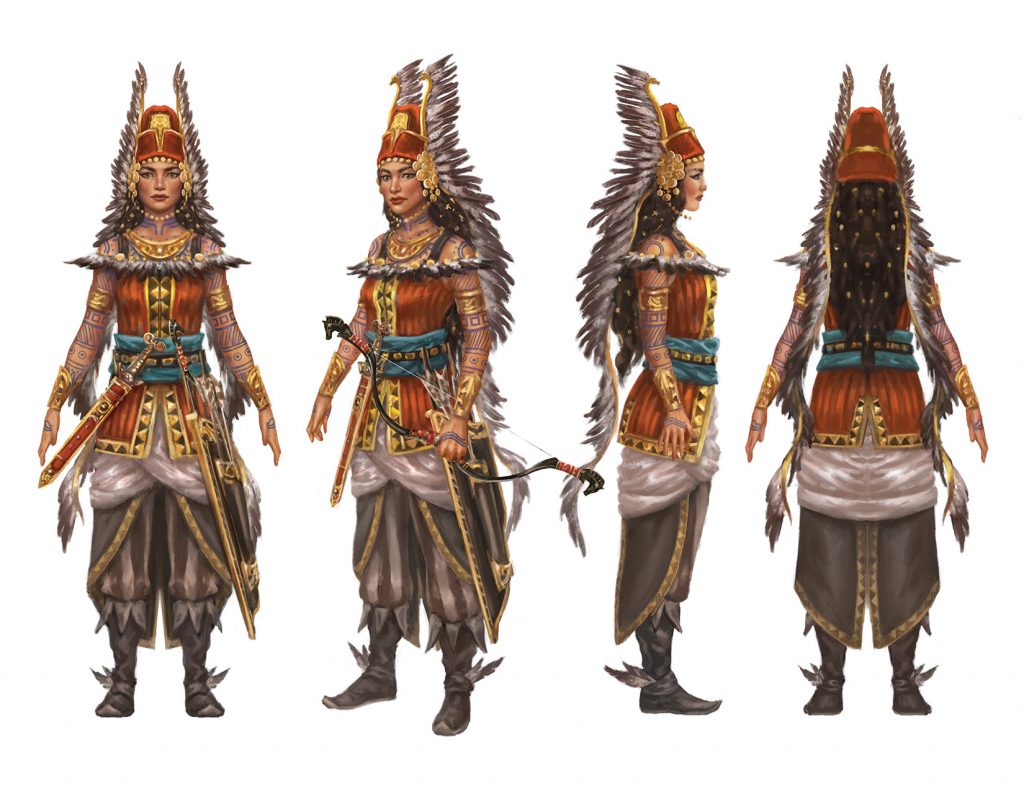
The groups are in a symbiotic relationships – the agriculturalists provide grain, fruits, vegetables, and “lesser meats”, the townsfolk provide crafted goods, and the horse herders provide military protection and animal products from their herds. The horses benefit from this – the horse herders raise them and tend them, the farmers provide them with additional fodder, and the townsfolk trade part of the herds to outsiders in exchange for goods and coin which benefits everyone.
These groups are actually pretty small – there are about 18,000 farmers, 18,000 horse herders, and about 4,000 townsfolk. The area is geographically not all that big, only about a 1000 square kilometres, which actually means that the Grazelands are about as populated as the settled parts of Sartar.
Ernalda, not Dendara, is the Earth Goddess. She is the spouse of Yelm AND Orlanth, and unites horse herder and farmers together. Her cult is the largest in the Grazelands – as large as Orlanth and Yelm’s combined! The Ernalda cult is led by the Feathered Horse Queen. When the Pure Horse People and the Orlanthi farmers seemed destined to destroy the Grazelands, a priestesses descended into the womb of the Earth and returned with the secrets and power of Ernalda the Earth Mother, whose favors both Yelm and Orlanth must contest for.
This is the story of first Feathered Horse Queen. As far as I can tell, the historical context starts with the settling of Tarsh’s Twin Dynasty, which we talked about last week. When they entered what would become Tarsh, they met the Purse Horse People, the horse herding Grazelanders we were talking about. There was some falling out between the two, so that the Purse Horse People stuck to their side of the land, and the Tarshites to the other side.
For a while it seemed like the Grazelanders would be stuck in the hills for a few generations until they faded away from their reluctance to spread around, and their growing infighting. But in the early 1450s a priestess of the ancient Earth cults of the Grazelanders went into the Earth and gained the blessing of the local goddess, which was revealed to be Ernalda, I guess. The priestess came back with not only the blessing, but also some really cool headdress that reminded everybody of old Earth traditions of the Pure Horse People. The Sun King of the Grazelanders tried to protest but he lost the contest against the new Queen.
And so this new Queen is yielding a lot of power while also walking a fine line between the solar and storm cults. The interesting thing is that against the worse instincts of the concerned parties, the Feathered Horse Queen is making this cohabitation work: storm-worshipping farmers and sun-worshipping horse breeders, kept in check by a powerful earth-worshipping population. Talk about a menage a trois… literally. I imagine that heroquesting the Grazelander mythic realm is like some kinky sitcom. But that’s what the Earth is good at: weaving communities together, finding compromises, loving everyone. And everybody gets something from it anyway: the farmers get protection, and the Pure Horse People have the support system that lets them live their magical nomadic life “purely”.
The other Lightbringers are also important – more than half of all townsfolk follow one of the Lightbringers. And Humakt is also important as the primary War God.
The prevalence of Humakt’s cult in the Grazelands also seems to be a consequence of the early Feathered Horse Queen’s political moves. She restored a Humakt-related cult among her ranks and got some scary looking bodyguards, just in case.
Jeff adds a few comments:
A lot of the wrong assumptions about the Grazelands is a result of looking at Dragon Pass from stories that largely predate the Feathered Horse Queen or Sartar.
In the 1450s, the Pure Horse People were staring at extinction. Tarsh had built up its own cavalry force and no longer needed the Pure Horse People – even worse, they were importing Praxian mercenaries! The local Orlanthi farmers who had been forced to raise grain for the Pure Horse People needed only ally with Tarsh and could be rid of the Pure Horse People. Worse yet, the Sun Lords of the Yelm cult couldn’t see this and insisted that the Earth priestesses remained subservient in the traditional “Dendara role”. One of the Earth priestesses descended into the womb of the Earth in search of secrets.
Queue the history I told above.
The Feathered Horse Queen is who emerged. She placed the farmers under her personal protection and defeated the Sun Lords in magical contests, forcing the Stallion King to submit and pledge obedience. She issued the Marriage Contest to find allies and it was Sartar the Prince who proved his worth. Sartar built trade posts with temples to the Lightbringers, issued coins, and facilitated trade through the Grazelands. The trade posts became towns where crafters congregated. In short, the Grazelands were radically transformed by the Feathered Horse Queen AND by Sartar into something new. Horse breeder and farmer found a way to coexist through the person of the Feathered Horse Queen. The trading posts brought wealth – but also scribes, merchants, crafters, healers, mercenaries, and the rest of the accoutrements of civilization. The Pure Horse People certainly tell stories about how they are Yelm’s chosen and the spiritually elect and all that jazz. But it was the Feathered Horse Queen that allowed them to survive. And everyone knows that.
And thus just like the Orlanthi tribes of the Quivin Mountains were transformed by Sartar, the people of the Grazelands were transformed by the Feathered Horse Queen. Add more than a century to build upon that transformation and you have the Grazeland Pony Breeders we first saw in White Bear and Red Moon.
Lunar Provinces Cult Demographics
Jeff talks about cults in Aggar, Holay, Imther, Tarsh, and Vanch:
There are a little less than 1.4 million humans in the Lunar Provinces. Looking at the Provinces as a whole, the largest cults (those with over 10k cultists each) are:
– Ernalda 167k
– Seven Mothers 164k
– Orlanth 132k
– Yelmalio 72k
– Pelora (Oria) 52k
– Hon-eel 51k
– Lodril 41k
– Hwarin Dalthippa 40k
– Issaries 20k
– Oslira 20k
– Chalana Arroy 18k
– Lhankor Mhy 13k
Etyries is at less that 10k, so doesn’t make the list… the Provinces are mostly Orlanthi culturally speaking so their merchants are probably leaning towards Issaries.
Looking at it as a whole, there is a big Lunar belt stretching from New Lolon to Furthest and centered on Mirin’s Cross. But beyond that, the Provinces are pretty much Orlanthi. And it also has a few interesting localized cults like Jajagappa (with less than 10k cultists in total), some enclaves of the Shargash cult and over 5k wagoneers. There’s also a lot of Storm Bull cultists in Aggar – there are about three times as many Storm Bull cultists in Aggar than in Sartar!
Jajagappa is a psychopomp of the Dara Happan pantheon, a deity who fights the dead who escape their place in the Underworld. Shargash is a primal war god who destroyed the world.
I’m not sure why there are lots of Storm Bull cultists in Aggar though. Looking at the maps, I figure that it’s probably because Dorastor, land of Chaos, is nearby. These Storm Bull cultists might have less to travel if they were based out of Skanth or Bilini, but according to the Guide the Bilini tribes are little more than a bunch of bandits, so maybe Aggar is the nearest best thing to get some good drinks.
Here’s a little more about the Lunar cults themselves:
The way it works is that we have many Lunar cults, each founded by a heroic figure who achieved god-hood in Time, plus a handful of associated cults (Yelm, Gorgorma, Natha, etc.) who have ties to the Red Goddess cult itself. The main vehicle are the Seven Mothers – Danfive Xaron, Deezola, Irrippi Ontor, Jakaleel the Witch, Teelo Norri, and Yanafal Tarnils (She Who Waits has no real cult) – either individually or collectively. They are the mortals who “gave birth” to the Red Goddess and form the mainstream mortal path to her secrets.
I’m not super knowledgeable about who the Seven Mothers are so let’s quickly look into it:
- Deezola was an Earth priestess, and now the “Keeper of Vows” and “Avenger of Wrongs”. Sounds a bit like a Babeester Gor sort of cult to me.
- Irrippi Ontor was an outlawed sage, which shows you can still do great things even after you get kicked out of school. He’s the “Master of Secrets”.
- Yanafal Tarnils was an exiled nobleman who somehow “defeated his master, Humakt, in battle”, and became the immortal Lunar war god.
- Jakaleel the Witch was a shaman-priestess, and became… err, wait, another “Keeper of Secrets”. Well I think Irrippi Ontor is more for knowledge, and Jakaleel is more for magic. Sounds to me like maybe she’s doing secret Lunar sorcery stuff.
- Danfive Xaron was a “bloodthirsty outlaw who volunteered for the most dangerous task” in the ritual to recreate the Red Goddess. He’s now the “Gatekeeper”, whatever that is. I seem to recall his cult is also good for atonement of crimes in the Lunar society.
- Teelo Norri was an innocent child, plucked from the streets, who didn’t know anything about the ritual… because apparently that was an important element of the ritual. She’s now the goddess of Innocence and Experience. Whatever that that is too.
- She Who Waits was a mysterious person whose identity is only known to Illuminated followers of the Red Goddess. My theory is that this was the Red Goddess herself, coming from the future or whatever. She helped with her own rebirth because she’s also cyclical overall inside of Time. Don’t listen to me though, this is nonsense… OR IS IT?
There are other vehicles as well – Hon-eel, Etyries, Hwarin Dalthippa, Glamour, Yara Aranis, Aronius Jarathir, etc. Plus there are those old gods who were associated with the missing goddess – Yelm, Gorgorma, Natha, etc. and of course Nysalor. So Natha has a tiny little cult that is associated with Gorgorma and Danfive Xaron.
Hey, plenty of names that I only vaguely know, or don’t now at all! Let’s get through them:
- Hon-eel is one of the daughters of the Red Emperor, who conquered many lands and discovered maize… because apparently everybody forgot about it.
- Etyries is basically the Lunar version of Issaries, the trader god.
- Hwarin Dalthippa is another daughter of the Red Emperor, also known as the Conquering Daughter, which we already talked about previously.
- Glamour was I think the first daughter of the Red Emperor but is also the city of Glamour? I’m not sure that Glamour ever walked around like the other daughters, though: I think she might have been created as a city from the start.
- Yara Aranis was the next daughter after Glamour, and the one whose powers maintain the Glowline, which we talked about here and here. Plus my look into the different versions of the rules.
- Aronius Jarathir seems to be a noble who became famous for his wars in the West Reaches. Somehow I suppose he built a hero cult for himself, but I don’t know more.
- Yelm you should know, that’s the sun god, duh!
- Gogorma I don’t know much: she has two mouths, devours things, and is Dendara’s sister Dendara is Yelm’s wife, the docile and well-mannered version of Ernalda, I think… so maybe Gogorma is sort of a Maran Gor?
- Natha is the “Goddess of Balance”, and I don’t know much either. She can bring all kinds of opposites, from Life and Death to Light and Darkness and whatever. It sounds like she’s scary and better kept propitiated without asking questions.
- Nysalor is, well, a whole thing. He was created by the Broken Council, founded an empire who was supposed to bring Light and crazy-ass Illumination to the world, wounded Kyger Litor and create the trollkin curse (woopsie), and got into a big war with Arkat.
Each of the Seven Mothers is associated with a moon phase:
Black Moon – She Who Waits
Crescent Come – Danfive Xaron
Empty Half – Yanafal Tarnils
Full Moon – Irrippi Ontor
Full Half – Teelo Norri
Crescent Go – Jakaleel
Dying – DeezolaSee – each of the Seven Mothers represent a phase of the Red Moon, but only the Red Goddess represents the whole.
Now some Lunar scholars try to map some other old gods onto that scheme to aid in heroquesting. So Orogeria gets associated with Crescent Come, Natha gets associated with the Full Half, Gerra with the Dying Moon, etc. Even poor Dayzatar gets associated with the Full Moon in some schemes. But this is more of an attempt to create a Lunar heroquesting map than anything that is widely practiced.
Lunar Heartlands Cult Demographics
And now, for the same thing in the Lunar Heartlands:
The Lunar Heartlands are home to almost 5.4 million humans. This is the center of Lunar culture and the Lunar religion, a fact made omnipresent by the presence of the Red Moon looming over the Crater.
The largest cult in the Lunar Heartlands is, not surprisingly, the Seven Mothers. If we combine their worship collectively and individually, we come up with a grand total of an amazing 850k cultists. That easily makes the Seven Mothers one of the largest cults in Glorantha, and one of the Big Three in Central Generela. Not bad for a desperate cabal of heroquesters!
And when we add the Lunar Provinces and the Western Reaches we easily get above 1 million members (probably above 1.1 million). So that is one BIG cult.
After the Seven Mothers, the largest cults in the Heartlands with over 100k cultists each are:
– Lodril 500k
– Oria 350k
– Dendara 170k
– Oslira 165K
– Yelm 150k
– Hon-eel 135k
– Surenslib 115k
Yay, once again names that I don’t know much about. Let’s gooooo:
- Lodril is a lustful fighter god of the Sky. He love to get down with the Earth deities, and he became the Volcano God. I’ll wait over there while you unpack the not-so-subtle phallic ejaculation references here. I’m not sure exactly what good Lodril is for nowadays… given the number of worshippers, I imagine he’s good for anybody who Works Hard, Plays Hard? But more seriously, I think he’s the farmer/fighter god of the Pelorian farmers. Sort of like Orlanth/Barntar for the Orlanthi, but with more dick drawings.
- Oria is the Pelorian Earth Goddess, and the Maize Mother. Her and Lodril are the main Sky/Earth power couple for the Pelorian masses, I suppose.
- Dendara, as we mentioned earlier, is Yelm’s wife. Although she’s associated to Earth goddesses, I get the impression that she’s more linked to the household, with good manners and well behaved children, rather than linked to the crops and fertility. This split between Oria and Dendara sounds interesting for Pelorian world-building because it doesn’t exist much in Sartar as far as I know.
- Oslira is the goddess of the Oslir river, and as such probably comparable to Engizi in Sartar. Her cult must be important for all the irrigation needed around the rice paddies that dot the Pelorian landscape.
- Yelm is, again, the sun god, duh. He’s historically important given that the Lunar Empire used to be a Solar Empire at some point.
- Hon-eel we also already mentioned. Lots of maize fields here.
- Surenslib is… err wait, Jeff talked about that one.
Now that last one is a bit surprising – that’s the ancestress of the Darjiini, and is a rather big cult. She didn’t make the cut in the Cults Book despite her size because her influence is totally localized and she’s not really of cosmological importance outside of Darjiin and Doblian.
Ok so that didn’t help much. As far as I can tell, Surenslib is the Heron Goddess, responsible for marshes and other wetlands, and… (checks notes) known as “lewd”. Yes, she’s wet, and lewd. My god, Lodril and Surenslib is what happens when game designers get horny.
Anyway, I checked out Darjiin and it’s a very densely populated Lunar province with lots of rice farmers, marshlands and small lakes, and a tight grasp on their old gods. Hence an obscure wetland goddess making the cut of the top 10 cults in the Lunar Empire.
We can think of Yelm+Lodril+Oria+Dendara+Oslira as being the backbone of the old Dara Happan civilization before the Red Goddess. But the Seven Mothers have now definitely eclipsed the old Solar Pantheon. They are still there, but more in the background. With the Red Emperor recognized as the avatar of Yelm Imperator, the old gods of Peloria now serve the Red Goddess.
And speaking of the Red Goddess, what’s her cult like, given that the requirements to join it are pretty insane? (you need to be a Runemaster of a qualifying cult, and be Illuminated) Well, Jeff thinks there might be around 8000 Red Goddess initiates.
The Eel-ariash Clan
A bit of a deep cut here, but Jeff is talking about the Eel-ariash clan, a prominent noble family in the Lunar Empire:
The Eel-ariash come from Doblian, and were the family of Sandene, a village weaver woman who had protected the Red Emperor when he hid from Sheng Seleris. The family first appeared in the chronicles around 1460s thanks to the deeds of their most famous daughter, Hon-eel the Artess, who was revealed to be the daughter of Sandene and the Red Emperor.
The Eel-ariash accompanied Hon-eel on her rise, becoming her priests, administrators, and household. When Hon-eel resettled Oraya, one of her kin was appointed Satrap in 1587. The family was greatly weakened in the Nights of Horror (1506) and lost control of that satrapy but they aided the Molari-sor in seizing that satrapy in 1521 and one of the most famous Dart Warriors of all time, the Chain Dancer, was a member of the family. In 1543, the Eel-ariash took over the Oronin satrapy, despite the opposition of the Red Emperor.
You might remember that Sheng Seleris was a sort of Solar Genghis Khan figure who almost destroyed the young Lunar Empire with his horse-riding nomads. The Nights of Horror was one of the biggest battles between the two.
Dart Warriors are the operatives who take part in the Dart Competitions, a sort of “officially covert war” between Lunar noble families. I thinking “Roman Senate meets Jason Bourne”, here.
It is said that every action Chain Dancer made was part of a magical ritual taught by Hon-eel in his dreams. The results of his dance was the birth of the woman Farangold, who served as the concubine of the Red Emperor and gave birth to Jar-eel the Razoress in 1588.
So the Red Emperor needed some hardcore CIA spy to get a date? Wow, what a dork.
Among the relatives of Farangold was her nephew, Sor-eel, who was given command of the conquest of Prax in 1610. He was aided by a Tarshite officer, Fazzur Wideread, who became governor of Dragon Pass in 1613. In 1621, Sor-eel was relieved from his governorship of Prax by the Red Emperor after a remarkable magical artifact – a Giant Cradle – slipped out from his fingers. Sor-eel returned to Glamour, and he now serves in his cousin’s household.
Now obviously, the Eel-ariash are an extraordinary family, but we have a family descended from a weaver woman and the Red Emperor, whose descendants include a corn goddess, two children of Yelm (!), one of the most skilled Dart Warriors of history, satraps, generals, governors, and of course Jar-eel the Razoress.
Not to mention at least one Mask if not more.
Lunar Nobles of Alkoth
Let’s keep talking about Lunar nobles… Mark Durston asked about noble families in Alkoth, and got a big enough reply from Jeff that I’m featuring it here.
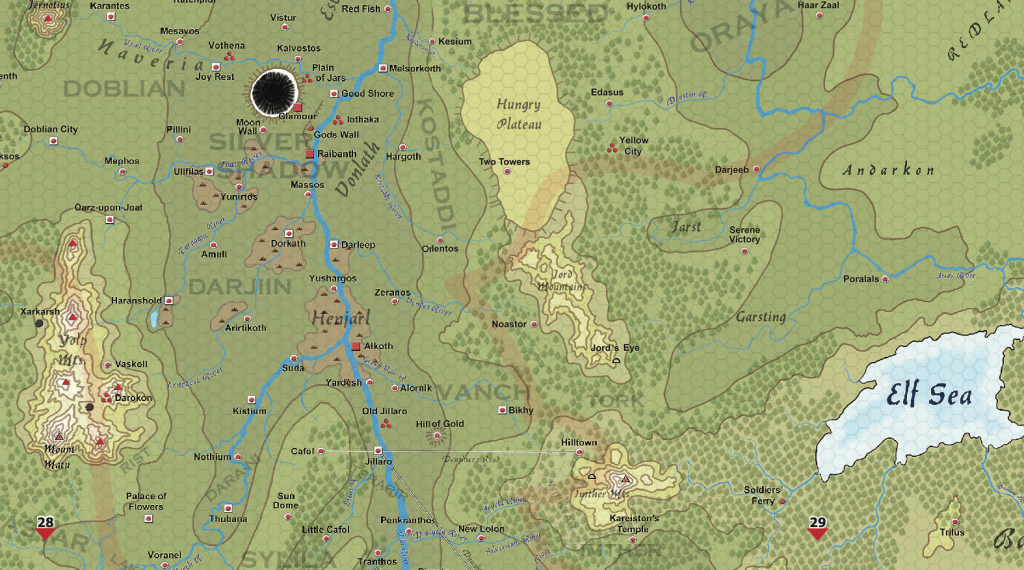
First, let’s figure out where Alkoth is, thanks to the Argan Argar Atlas. You can spot the city in the middle of the map, along the Oslir river. It’s one of the three main ancient Dara Happan cities, with Raibanth and Yuthuppa, and the last of them to have fallen to the Lunars. That’s possibly because Shargash (a primal war god) is the city’s official god, so they are known to have pretty bad-ass warriors. There’s more information in the Guide about this big city (classified as a “metropolis”, which means 25,000 residents or more).
The city is the center of the Shargash cult, with roughly some 4000 cultists. It is a Lunar city and has 5000 Seven Mothers cultists – most here are going to be dedicated to an individual Seven Mother (Deezola, Yanafal Tarnils, and Irrippi Ontor probably the biggest cults). It is also one of the centers of the Yelm cult with 2000 members. There’s another 9000 adults in Alkoth – so we have lots of Dendara, Oslira, Biselenslib, Lodril and Lowfire cultists as well. I expect there might even be 150-200 Red Goddess initiates.
The ruling elite in Alkoth are going to be Lunars. Some are Yelm cultists, some are Shargash cultists – but all of the ruling elite accept the Red Emperor. In fact, this is where much of the conflict within the elite comes from: competition for the attention and favour (or disfavour) of the Red Emperor and his court (in reality it is mainly his court).
Free, family Alkorneval is an ancient family with members holding senior positions within Yelm and Shargash cult (particularly the Alkor subculture), as well several Red Goddess initiates, officers in the Yanafal Tarnils cult, Irrippi Ontor scribes, etc. They have been leaders in the city since the liberation of the city in the Fourth Wane. However, they are largely of regional ties and importance, with few contacts outside of Henjarl.
The liberation mentioned here is because Alkoth was occupied by Sheng Seleris and his Pentian nomads from 1404 to 1423.
Alkorneval are locked in conflict with the Full Moon Blesses Us family, originally from the Hungry Plateau. They were installed in several key city positions about a dozen years ago, due to the intrigues of the Mother of Strength and the Tharkalists. They revere the Seven Mothers (in particular Yanafal Tarnils and Deezola), but are headed by a Jakaleel-Red Goddess shaman. The Full Moon Blesses Us family have relatively few local connections (although they were given ownership of the Raus domains in Kostaddi after a rebellion about a decade ago), but they have very good ties to Glamour and Two Tower.
Ok, let’s look at the names I don’t know…
- The Hungry Plateau is visible in the map above, east of Glamour. There’s a tribe of Sable Riders living here, related to the Praxian Sable Riders. No idea if the Full Moon Blesses Us family are Sable Riders who became sedentary or what… but I assume so, since the Mother of Strength who put them in Alkoth is their shaman ruler (and the ruler of Kostaddi province).
- The Tharkalists are the seven daughters of the Red Emperor, born some time in the mid 1570s. They’re all born from different mothers, but are identical except for one feature each. It’s a Village of the Damned sort of situation, I guess (you might be more partial to the older 1960 movie). Now grown up, they are at the head of the newest of the big influential noble families. Creepily enough, the Tharkalists had children with the Red Emperor… yeah. Ewww.
These families are engaged in a low-level Dart War, with spies and assassins trying to embarrass the other family in the eyes of the Imperial Court.
Remember that Dart Wars are the covert schemes that Lunar noble families run against each other to maintain or increase their position in the court.
So both families likely motivate themselves with their Loyalty to the Red Emperor – heck they want to show how loyal they are and how disloyal their rivals are. These conflicts are over power, status, and personal connections, and not really ideological as we would understand them.
Jeff then gives pointers to bring another faction — possibly a patron for adventurers in a Lunar campaign:
Now if we want to throw another family into the mix, we might have some powerful administrator appointed by the Court, perhaps even a son or daughter of the Red Emperor. He has a lot of those, and this is from a previous Mask, so no particular personal connection with the current Mask. But it is a child of Moonson, and thus a grandchild of the Red Goddess (and theoretically a sibling of Jar-eel and others) so is owed respect and fealty (especially from the Yelm cult). But of course, the reality is that they need to build their own power base and has decided to start here in Alkoth.
So now you have a three-way conflict. Given the size of Alkoth, there are likely far more than this, but at least we can see the contours of elite conflict.
Hero Cults
Jeff talks about hero cults:
Many heroes and “living gods” have cults while they live. Those cults provide the hero with magical resources – however, these cults do not directly provide the worshipers with Rune spells. Instead they insure that the hero can continue to protect, defend, bless the community – or sometimes just so that the hero is well-inclined towards the community!
In RuneQuest, mechanically speaking, I suppose that these cults provide the hero with “Hero Soul points”, which were obtained during heroquests and other epic magical feats. From what we know of the upcoming heroquesting rules (and the preview from The Smoking Ruin & Other Stories, page 187), these points are like Rune Points, in that they let you cast special magic, but they get replenished not when you worship someone, but when people worship you.
The Red Emperor is probably the most widespread example of this sort of “living god” cult, although Belintar, Sir Ethilrist, Cragspider, Jaldon Goldentooth, Jar-eel, and others also have cults (Godunya’s cult is a very different animal).
Now these cults have priests, some who are secunded from other associated cults (like the Red Emperor’s cult being built off the Yelm Imperator infrastructure in the Lunar Emperor or Jaldon Goldentooth using the existing Waha cult. They get material benefits from the hero (like access to spirits or special spirit magic).
That’s a clever way to get a whole bunch of potential worshippers, but I imagine you have to make extra sure the primary deity won’t get pissed off that you’re taking a cut of the action… I wonder if someone ever got in big trouble for that…
When a hero is associated with an existing cult, their cult might function as a subcult that provides access to special Rune magic from the god – not from the hero. The hero might show a path towards that Rune magic, but the god is the source of it, not the hero. Think of the hero as the guide that shows the way to the god’s special magic, and not the source of it.
I guess that’s a good way to introduce new Rune spells!
So in the Holy Country, Belintar had many temples and countless “lay members”. He had priests – but those priests were also priests of the gods of the Holy Country and led Belintar’s worship ceremonies as well. In addition to provide massive magical resources for Belintar, these ceremonies were connected with the Tournament of the Masters of Luck and Death, and Belintar carefully made sure that the various gods of the Holy Country had their representatives in his “cult”.
Leftarm Islands
And since we were just talking about the Holy Country, let’s go there!
Off the southern tip of Heortland is the area called God Forgot. It is associated with the Bandori valley and the Marcher Lands. Collectively this area has about 100,000 human inhabitants, roughly evenly divided between God Forgot and the territories on the mainland.
Let’s bring the map!
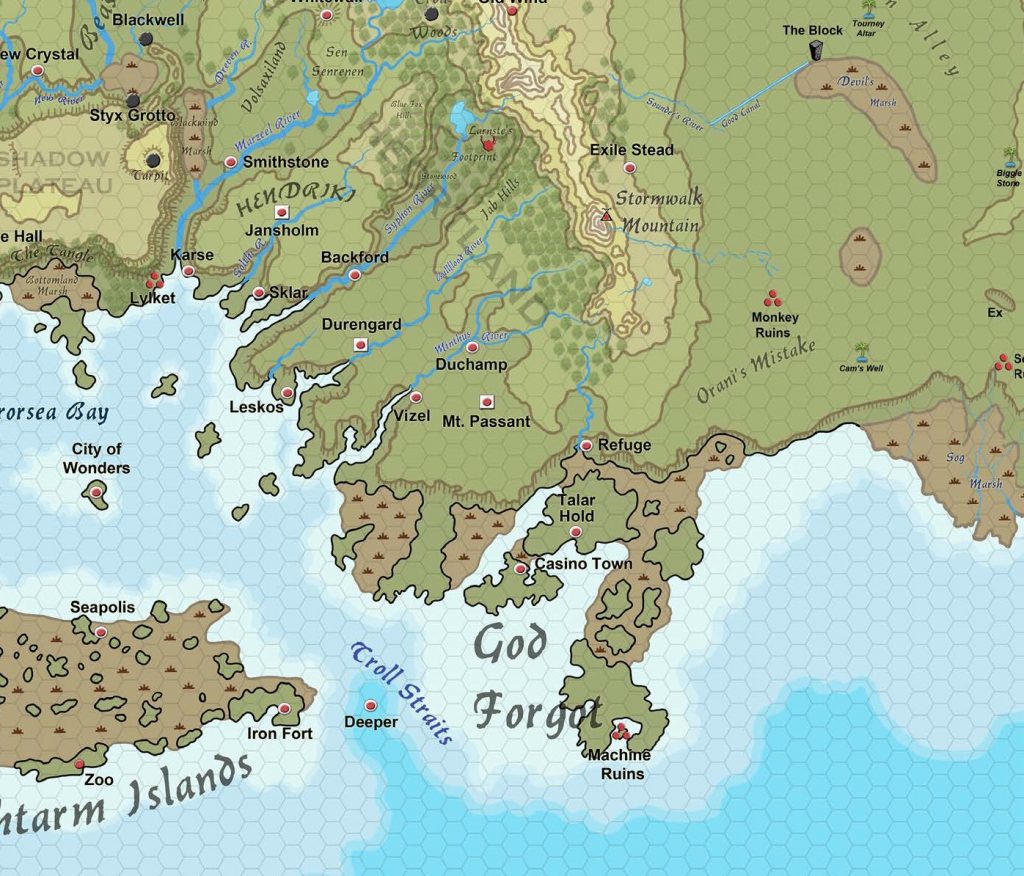
The Bandori valley is around the river that passes through Refuge. I’m not sure where the Marcher Lands are but I assume they’re the wetlands to the southeast of Refuge.
God Forgot is dominated by a pre-Hrestoli variant of Malkionism. More than half the adult population (20k) worship no god except the Invisible God. These people strictly follow an ancient caste system of laborers, soldiers, sorcerers, and rulers. The rulers of this area are claimed to be from Brithini, as are several sorcerers. They came here in the Second Age and managed to survive the wars that destroyed the Machine City. There is a sizable minority of Aeolians (7.5k) particularly among the farmers and soldiers. Many coastal fisherfolk worship Choralinthor (3k) and there is a small cult centered on Casino Town that worships only the Goddess of Luck, Who Giveth and Taketh Away.
Aeolians are sort-of-gnostics who believe the Invisible God to be the creator of the cosmos, but also consider the gods to be “emanations” of him… so they are basically Orlanthi people who go “<wink wink> we know who Orlanth and Ernalda really are, right? <wink wink>“. For more on Aeolians, see issue #24 of the Journal.
The Mirrorsea Bay (in the centre of the Holy Country) is also named Choralinthor Bay, so you can bet that Choralinthor, the god, lives down there. It’s probably a good idea to worship the guy when you live on its shores.
Refuge is another Brithini outpost that follows the ancient caste system. Almost half the population of Refuge follow the Invisible God (1.5 k), with the next most important cults being Aeolianism and Choralinthor.
Rural Bandori and the Marcher lands are more like Esvular in Heortland. The largest cults here are Aeolianism, Orlanth, Ernalda, and Eiritha. Humakt has a major temple at Marcher Fort, which defends the passage to Prax.
Refuge
We were just talking about the area around Refuge, so here are some more notes:
The city of Refuge is port city in God Forgot and a Brithini outpost which continues its tenuous existence using the old caste systems of Brithos. Cautious and defensive, the rulers are ancient and canny politicians and rarely act rashly. The city has an ancient alliance with a tribe of Esvularing peoples called the Bandori. Beginning in 1620, a flood of refugees from Heortland has swollen the city’s population.
This would be refugees fleeing the Lunar Empire’s expansion, I suppose.
Refuge has a great temple to the Invisible God, major temples to Aeol and Choralinthor, minor temples to Orlanth, Ernalda, Issaries, and Lhankor Mhy, and shrines to Chalana Arroy, Dormal, Humakt, Waha, and Eirtha. Because of the refugees from Heortland, the temples to Orlanth and Ernalda are now effectively major temples.
There must be interesting stories to tell when a minor temple’s resources become strained under the pressure of too many worshippers… Not just because there’s not enough room for the ceremonies, but also because there’s not enough staff to teach skills and spells, or because the temple wyter can’t get everybody onto the God Plane for big rituals. The leading priest there might be quite liberal in appointing God Talkers, which means that adventurers could easily get a promotion even if they barely qualify…
The ruler of Refuge is the brother of the Talar of God Forgot. He is a Brithini, and is aided by several sorcerers and by his fearsome bodyguards.
About a third of the city’s population are God Forgot Malkioni. About 10% are Aeolians. The rest is a motley mix of Heortlanders, Praxians, Boat People, and Esrolians.
There are caravans that head out from Refuge to the Monkey Ruins and into Prax. That route is greatly preferred to the route to Corfu and then upriver to New Pavis.
It’s a fun route: you pass by the Monkey Ruins, with plenty of baboons and Oakfed cultists, and then you get to Biggle Stone, with its weird humid mushroom forest in the middle of the chaparral. It’s a nice change from Caravan Alley!
Karse
Elsewhere in the eastern Holy Country is the city of Karse:
Karse (large city): This ancient port city is an important trade center with Dragon Pass. Goods are transferred from ship to caravan here. Karse is located on the coast, a few kilometers from the mouth of the Marzeel River. The high Heortland cliffs rise a few kilometers behind the city and the Shadow Plateau. Karse is a very old city, dating back to the Dawn. Temples to the Sea Gods stand near the harbor, a natural inlet that has been worked on for the last 1500 years or so, most recently by Prince Tarkalor Trollkiller and his Sartarite stonemasons.. The city has many warehouses and inns, including a Geo’s Inn.
Karse was listed as a “small city” (500 to 6000 residents) in the Guide to Glorantha. Jeff lists it as a “large city” here (6000 to 25000 residents). Given that Jeff also notes that the city’s area is 40 hectares, with about 150 people per hectare, that comes up to 6000 residents, which is exactly the cut-off between the two categories. The city might have grown a little bit between the Guide’s 1621 and RuneQuest Glorantha’s 1625, enough to push it in the next category.
Either way, you can see Karse in Hendriki on the map featured a few sections above. And here’s a sketch of the city itself, which we already saw in a previous Journal, when we compared Karse to Massalia:
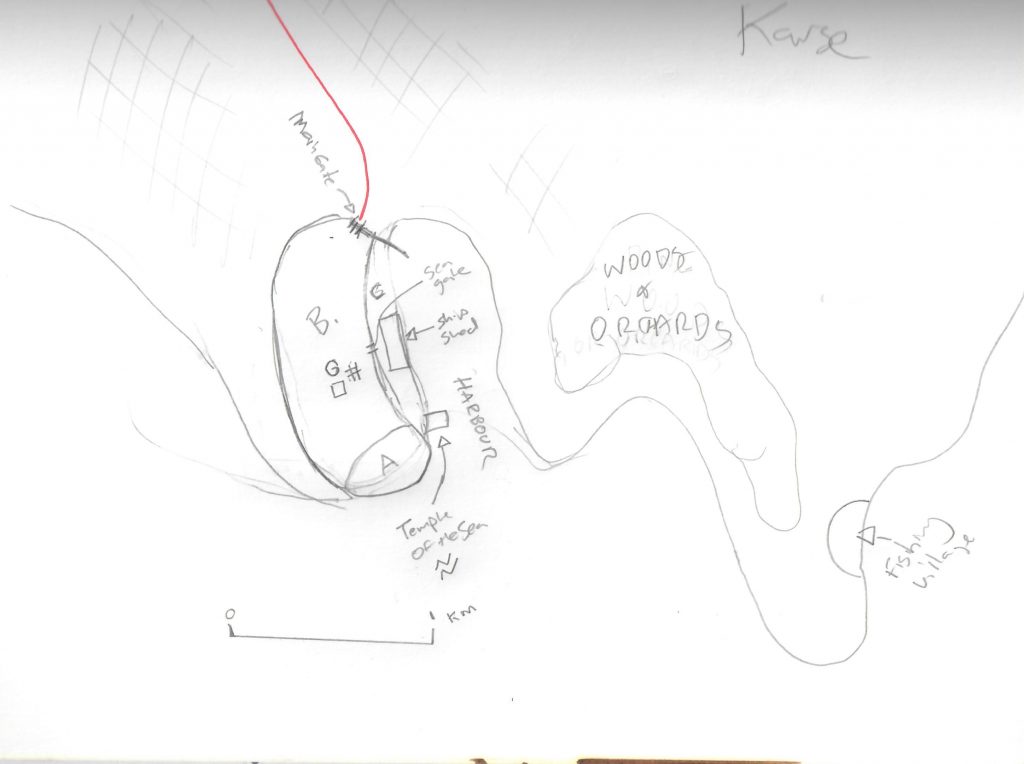
Unlike Massalia, though, the high cliffs around the city means that it’s probably in the shadows for several more hours every day, with less daylight than other cities in the region:
I expect night comes a little early to Karse, as the kilometre high cliffs of the Shadow Plateau are only about five kilometres away. Before the Only Old One was defeated by Belintar, the Tower of the Palace of Black Glass would have been clearly visible about 20 km away, a huge structure that rose to the Middle Air.
And with the Shadow Plateau nearby, “Argan Argar is of course important in this area, second only to Orlanth and Ernalda“.
[Karse is] a stronghold of the Argan Argar cult, so very troll-friendly (by necessity if not by inclination).
On a trade and travelling note, Karse is the beginning of one of the Royal Roads of Dragon Pass, which lead you to the Sartar Roads and, if you want to go that far, the roads leading to Pavis or Tarsh and Peloria:
Karse is an interesting base for a campaign as it has very strong connections to both Sartar and Nochet. It is the southern terminus of the Dragon Pass caravan route and so has merchants from the Lunar Heartlands, Esrolia, Prax, and even over the seas. Orlanthi are of course welcome there, but there are even some Lunars who remained after its conquest by the Hendriki.
From Karse, a campaign could easily link Sartar to the far off islands of Jrustela or Teshnos, get involved in Esrolian politics, and have to fight off Wolf Pirates.
Jeff also mentioned Prince Tarkalor Trollkiller: he fought some war here in 1560 against the trolls that almost caused these trade routes to be closed. I think these trolls are the Kitori, although they might be a slightly different kind of trolls, created by The Only Old One, the ancient ruler of the Shadow Plateau and son of Argan Argar… I’m not clear on this whole affair. Anyway, these trolls’ territory is now reduced to the Troll Woods, and the trade routes are relatively safe… or are they?! (cue some adventure seed)
For more notes about Karse, including what the labels point to on the map, again, refer to issue #27 of the Journal. Jeff adds a few details though:
There are a lot of inns – caravanserai – in the city, including a Geo’s Inn.
And:
The main city is strongly fortified with two main gates – a Land Gate (the main gate) and a Sea Gate that leads to the harbor – and a fortress that guards the harbor. Despite the seemingly impervious fortifications, Karse fell to the Lunar Army in 1619, after a dramatic assault by land and sea.
Karse has major temples to Orlanth Adventurous, Ernalda, Issaries, Argan Argar, Choralinthor, and Aeol, minor temples to Chalana Arroy, and Lhankor Mhy, and shrines to Diros, Dormal, Humakt, Lanbril, Magasta, and the Seven Mothers.
Another bunch of unfamiliar names!
- I’m not sure who Aeol is but I assume that’s the person who created Aeolianism (see above, and issue #24), worshipped as a cult hero of the Invisible God or something.
- Diros is the “God of Boats”, whose cult originates from the Second Age’s Middle Sea Empire.
- Dormal is the guy who “reopened” the oceans to deep sea travel, after figuring some sort of workaround to whatever magical mess caused the Closing.
- Lanbril is the Heortling Thief God. I’m curious about whether his temple is public, or something more clandestine, maybe along the lines of “everybody knows mafia boss Jimmy Two-Guns is found at the Strike One bowling alley“. I’m also wondering how it differs from Eurmali thieves.
- Magasta is an important Water god. He’s generally busy operating the whirlpool that bears his name at the center of Glorantha. Under the whirlpool is the hole left after the Spike exploded in the Gods War. I suppose that people sailing to Pamaltela (the southern continent) need to do a minimum of worship to Magasta to travel safely past him.
There likely was a shrine to Yelmalio but it was abandoned in 1619 and the cult played no part in the city’s liberation by the Hendriki in 1624.
And now what’s up in 1625 and beyond:
Not surprisingly, Karse after 1625 is in post-Liberation turmoil. The Lunars are gone, the Hendriki are leaderless and their brief kingdom is falling apart. Esrolians queen does not rule outside of her lands, although she has great influence on Karse. In the Shadow Plateau there are those that want to extend the Shadow again. But trade with Sartar is returning, and there is once again a free Prince in Boldhome.
Argrath becomes Prince in 1627 and one of the first things he is tasked to deal with by the Heortlanders and Esrolians is to stop the Wolf Pirates.
It sounds like Karse is often depending on Sartar:
Not only is Karse dependent on trade through Sartar for its livelihood but between 1570 and 1600, I would expect that most of the public architecture in Karse got built by the largesse of the princes of Sartar. Harbor, gates, temples, etc.
That stopped after the conquest of Boldhome, and then it was whatever the city could get the merchants to pay for – either directly through gifts and donations, or indirectly through market fees and tolls. That stopped in 1619 after the city fell to a Lunar military assault. After 1621, trade was severely disrupted due to war. The Lunar garrison was withdrawn late in 1624 or early 1625 and the city was ruled by the Hendriki, but they collapsed early in 1625. So it would seem likely that the place the oligarchs of Karse look to is Boldhome, now that there is a Prince again.
Caladraland
Let’s stay in the Holy Country, with one of my favourite places there:
Caladraland is one of the regions of the Holy Country, and one people don’t pay enough attention to! If we look at Caladraland as a whole (so Highvale, Porthomeka, Vinavale, and Thomble), the most important four cults are:
Ernalda 102k
Caladra and Aurelion 59k
Lodril 30k
Orlanth 30k
We already just talked about Lodril (see above), but here we’re dealing with the Holy Country version of his cult, which is bound to be different since farmers here would worship aspects of Orlanth most of the time.
Caladra and Aurelion are Lodril’s twin children, although there’s a bit more to them than that (see below).
A few interesting observations. If we look at Caladraland AND Esrolia, we have around 90k Lodril cultists in the Holy Country. That’s a lot. Sure the Ernalda and Orlanth cults are a scale of magnitude bigger than that, but Lodril has a bigger cult in the Holy Country than any of the lesser Lightbringers and is about tied with Argan Argar.
So of course the Orlanth cult of Dragon Pass is familiar with Lodril. They probably associate him more with the Vent than with Peloria. And yes, they know that the Volcano God of Caladraland (called Veskarthan) is Lodril and since the Second Age that name is likely more prevalent.
Caladra and Aurelion is also interesting. There’s over 60k members of that cult throughout the Holy Country, making it a solid second tier cult behind the likes of Lodril and Argan Argar. But the cult is almost completely localized in Caladraland, so there they are the biggest cult after Ernalda (and in Highvale they are actually much bigger than Ernalda or Lodril). Again, most Orlanthi in Dragon Pass have likely at least heard of the Twins. The Twins are children of Asrelia and Lodril, and thus siblings of Ernalda and Maran Gor.
The Guide mentions that the cult of Lodril in Caladraland (back when it was called Veskarthan) was “disrupted by the God Learners” with “their cult of Caladra and Aurelion”. I wasn’t sure what that meant but thankfully Jeff explained:
The God Learners realised that Caladra – a cult centered on the Vent was tied with Aurelion, a cult on the island of Jrustela. Both could be contacted together at Meetinghall Mountain in Slontos. The priests of each cult quickly embraced the connection to the other, as they realised their cult had a twin deity!
The cult was promulgated throughout the Middle Sea Empire from its core areas of Jrustela, Slontos, and Caladraland. However, with the collapse of the Middle Sea Empire, the cult only survived in Caladraland and environs.
So it sounds like the God Learners tried to bolster their volcano god by tying it to another volcano god, and the Caladralanders ended up with two gods for the price of one, all for themselves to enjoy. Neat!
Sartarite Land Ownership
This is a common question with newcomers to Glorantha: do you own the land your farm is on? Jeff has some answers:
In theory, all arable land belongs to the Earth Goddess. As a practical matter, cultivable land is usually allocated by her local husband (in Sartar, this is the tribal Orlanth cult or by the clan, or both). Normally, the clan claims what it can defend and work, and the tribe backs that up. As long as the rights and wishes of the Earth Goddess are upheld, the Earth temple goes along with this.
I read somewhere once that the Babeester Gor’s cult is responsible for enforcing this. So if someone messes up with the stones that delineate the plots of lands, they get a visit from… well… let’s just say no one messes up with the stones.
The tribe or clan might alienate their community rights over some piece of land and assign it to a temple, another tribe, or even to the Prince of Sartar. This is how the cities worked – the tribes all gave up their exclusive rights to part of their land and gave it to a council made up of all the tribes. It is even possible for a tribe or clan to be convinced to alienate some land in exchange for a lot of silver. But again, in all of these cases the rights of the Earth temples need to be acknowledged (which is usually a percentage of the harvest). All of this ends up involving a lot of haggling between armed kinship groups. But in theory, the tribal king can have the clans give up land in order to support retainers, priests, etc (which is exactly what happens in a few scenarios). This land usually already has people that are working it, so it is really about who gets the additional renders – the clan, a thane, the tribe, a temple, whatever.
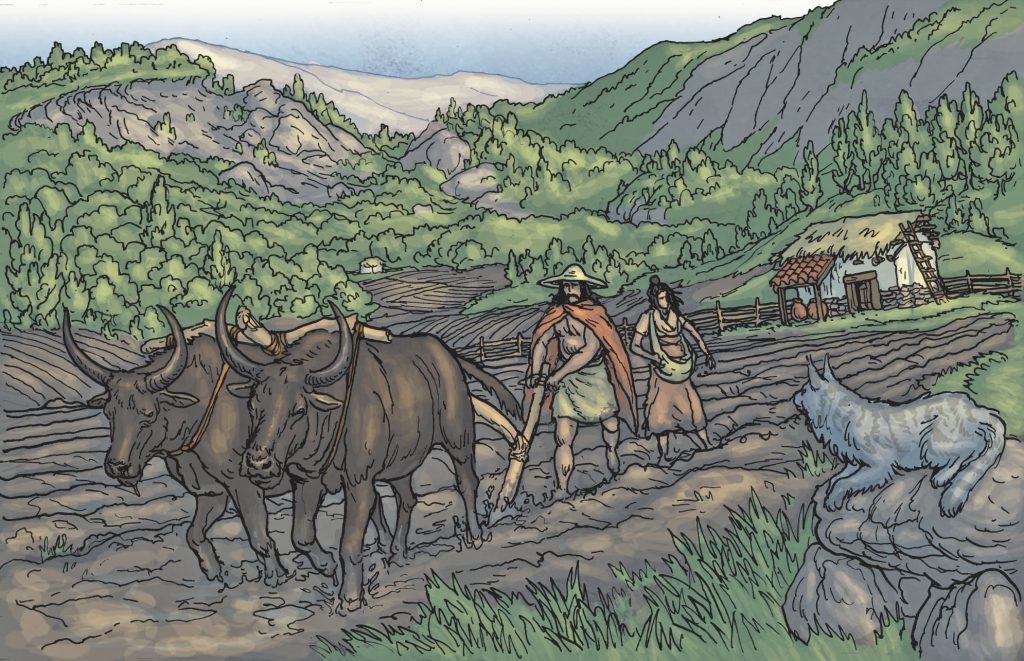
Pasture lands are handled differently. The livestock graze wherever they can be defended. If you graze your herds in lands claimed by another tribe or clan, they might gather some warriors together and chase you off. If you can defend your herd then either the clan or tribe needs to get a bigger group of warriors or needs to tacitly accept it. Clans mark their boundaries in order to signal what they are willing to protect and claim as their own.
If this whole thing sounds pretty turbulent, that’s because it is. Thanks to the Sartar Dynasty, there has been a non-violent means of resolving disputes over land – appeal to the Prince. That’s kept these borders from changing a lot, which in the long run tends to make things more secure. But from time to time a clan or tribe loses land because it simply can’t protect it any more and the Earth Temple no longer acknowledges them as its protectors.
At a certain point, Orlanthi land rights are what you can get others to accept, mainly though kinship ties, cult status, and personal might.
I think this is broadly speaking the system of land ownership found throughout the Orlanthi Belt from the Holy County through Maniria, Dragon Pass and the Pelorian hills to Ralios and Fronela. I expect we have a different system in Dara Happa and in the Malkioni West.
Lunar Land Ownership
Continued from the previous item, Jeff added this:
So for example in the Lunar Heartlands, we get a complex and hierarchical land ownership system. Here’s some thoughts:
The Red Emperor owns personal and royal property which is used as he sees fit. He additionally exercise dominion over conquered lands (such as in the Lunar Provinces), and can give this land to whoever he wants. Owners of conquered lands are rarely displaced and are usually allowed to continue living on and working their lands. However, they have to share the profits of the land with their imperial overlords.
Nobles can own land on a restricted and unrestricted basis. Nobles obtained land by purchasing it from other nobles or as a gift from the emperor for service to him or the Lunar religion. Purchased land can be sold or willed. Land grants from the emperor sometimes have conditions that required them to be returned to the emperor upon the death of the owner. Lunar citizens have similar rights to purchase land or receive it from the emperor. Institutions such as the army, temples, and certain public offices could also own land which was received from the Emperor. These entities own the rights to the profits from the land and use them to support the office holder. However, the individual office holder did not own the land.
Commoners cannot own land on an individual basis. However, they have access to land through their village or kinship groups and they are permitted to choose a headman to manage the distribution of communal land. This land is given to individual families, and generally stayed with the family unless it goes uncultivated for two years or the family moves away. If this occurs, the unused land is then redistributed to other families.
And now some comment on conquered lands, in both Orlanthi and Lunar cultures:
When the Lunars conquered land, the Red Emperor (through his proxies and representatives) claim the right to dispose of such lands as they wish. Of course, they have to be able to enforce these decrees, which means it is actually usually just demanding that they get paid a portion of the harvest or market fees etc.
Sartarite conquests tend to be more limited. A defeated locality is forced to acknowledge the authority of the victorious king or tribe or whoever. So a village might be forced to stop supporting the defeated tribe and to join the victorious tribe instead.
In the Hero Wars, when Argrath conquered locations, he generally stepped into the shoes of the defeated rulers, taking those properties the Lunar government had reserved for itself, and generally leaving other arrangements aside.
Community Roundup
The community roundup is our highlight of interesting things being mentioned in the Glorantha-related Facebook groups, sub-Reddits, and other similar online places.
Exploring Glorantha Episode 14
JM and Evan take a look at the Aldryami, the elves of Glorantha. I haven’t watched this because I was a bit busy this week, as you can see from the very first item in the newsletter!
Jonstown Compendium POD Unboxing
God Learner friend RPGImaginings is showing off many Jonstown Compendium books in this video, which is great if you want to check out what the printing quality looks like for these print-on-demand titles.
Starter Set Unboxings and Short Reviews
Did you think everybody had done their unboxings and reviews of the RuneQuest Starter Set by now? Think again! We have two videos this week: one from the Tabletop Gaming Guild, and one from Erik Tenkar (of Tenkar’s Tavern, a pretty well known community around the D&D/OSR crowd).
Rhino Rider Miniature
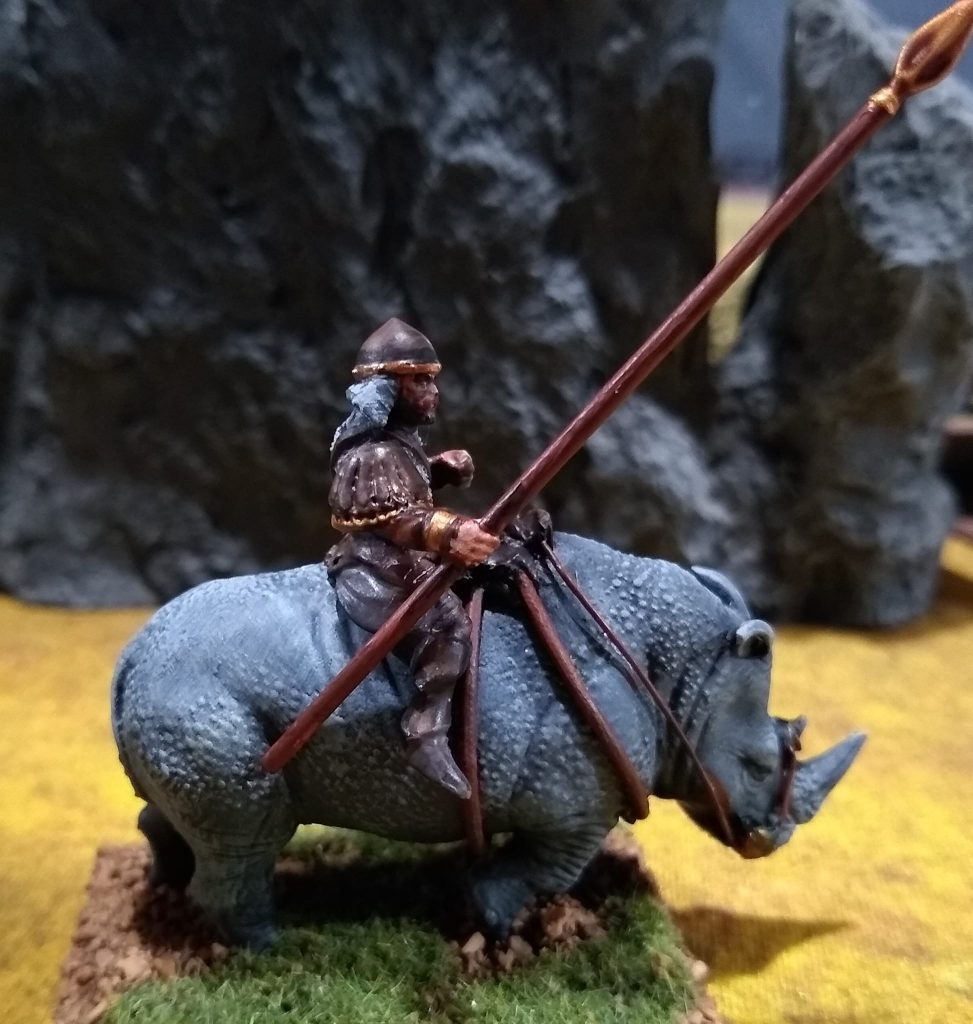
Barry Lee has this very nice partially-custom made miniature of a Praxian Rhino Rider!
Rolling Boxcars Reviews Apple Lane
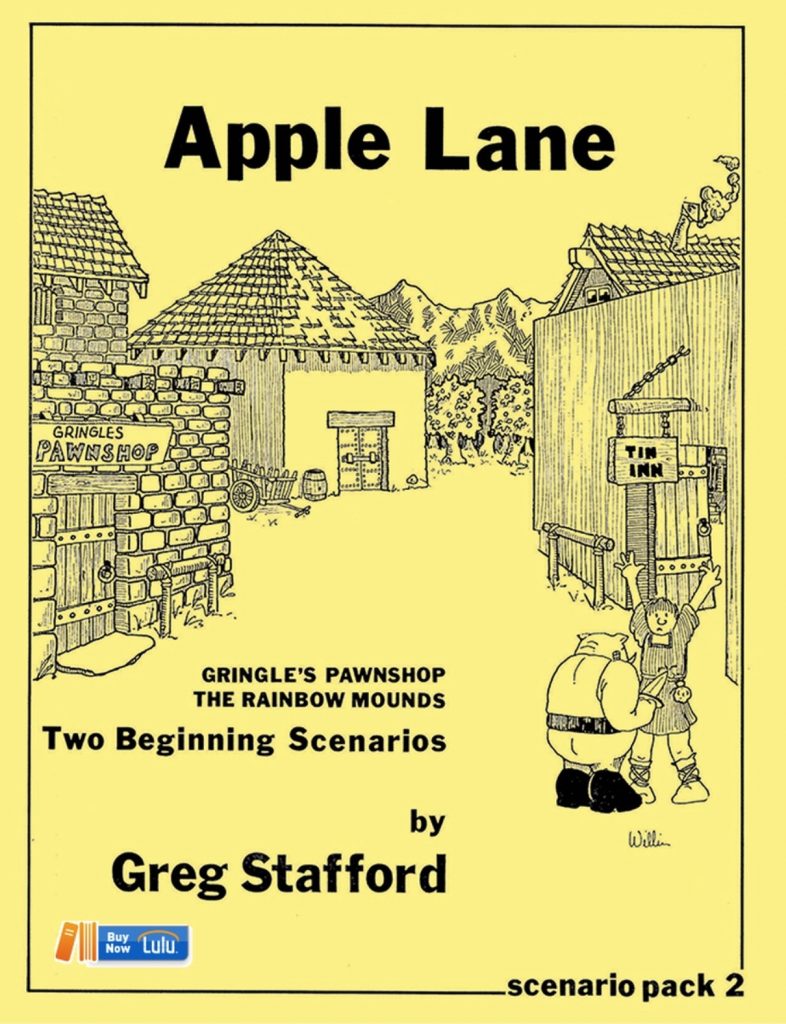
Keith aka Modoc reviews Apple Lane (now available in print-on-demand), the 1978 supplement for RuneQuest. While many old-school RuneQuest players here might have fond memories of this classic, it’s always good to realize that it hasn’t necessarily aged well in many aspects. Check out the review to see what the module looks to fresh eyes!
Six Ages at GDC
Talk about the intersection of my job and by hobby! Here is David Dunham at GDC (one of the main game developer conferences in the world) talking about the design of Six Ages. This is a presentation for game designers and developers, so while it’s not super technical, it does go into game scripting, procedural generation techniques, and so on.
Elsewhere on Arachne Solara’s Web
Not everything is about Glorantha, although most things are! Here are loosely relevant things that we found on the interwebs.
Orlanth Thunderous Shrine
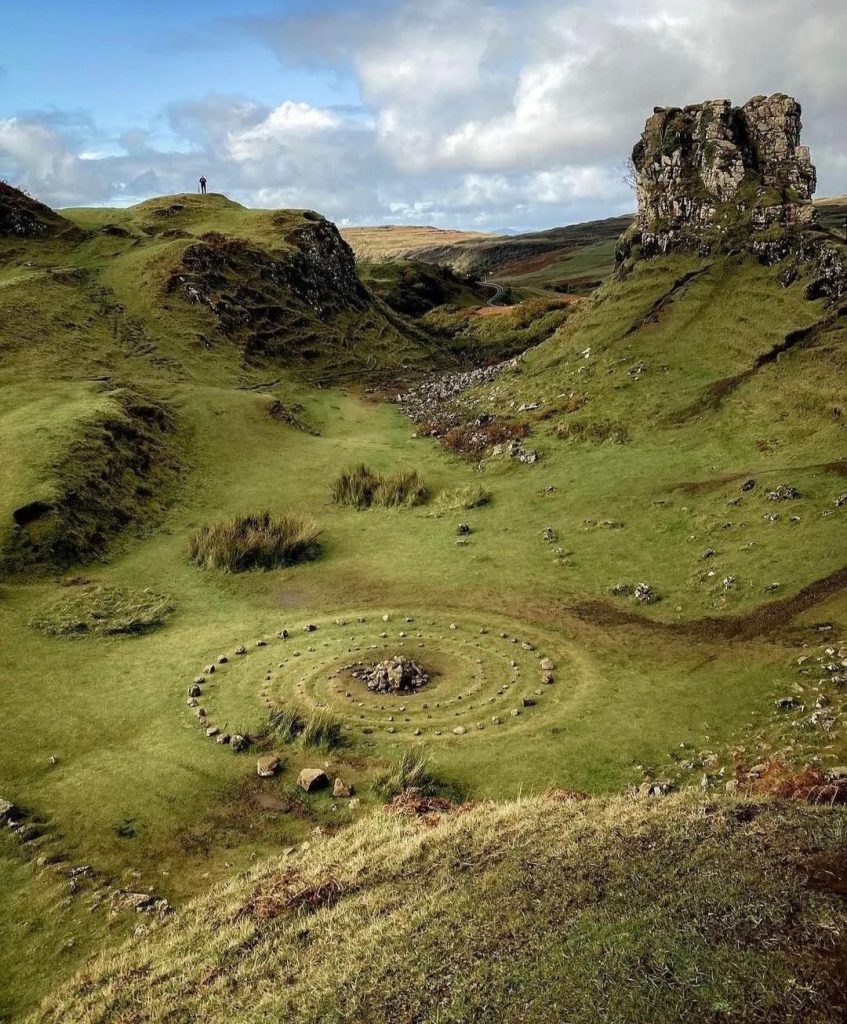
This is nice little spot on the Isle of Skye (in Scotland) is a good inspiration for an Orlanth Thunderous shrine!
Gravinis Passage Tomb
This Neolithic burial site is located an island in Brittany (France) could be another good inspiration for an adventuring site:
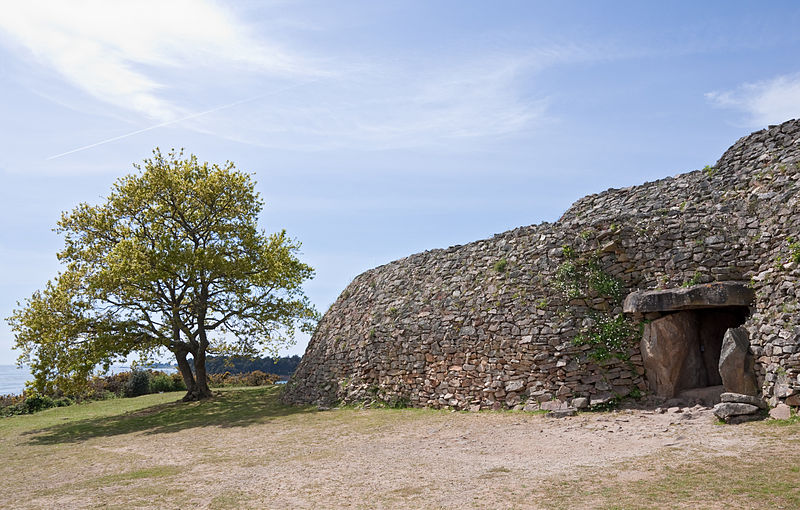
The Gavrinis Passage Tomb is an ancient burial ground which is thought to have been constructed around 3,500 BC. The site features a stone burial chamber which is covered in a cairn, or stone mound, with a mound of earth packed on top of it. When the tomb was constructed thousands of years ago, the island of Gavrinis was still connected to the mainland.
I really like the carvings inside:
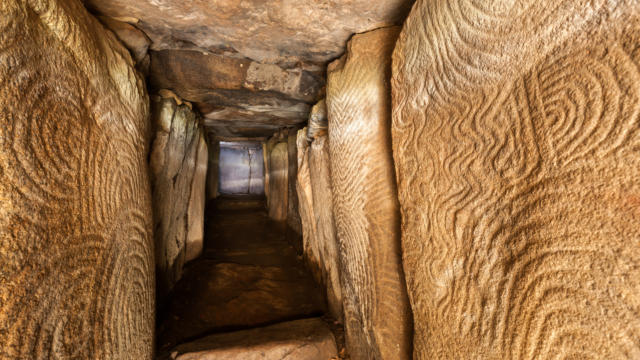
Thank you for reading
That’s it for this week! Please contact us with any feedback, question, or news item we’ve missed!



One comment on “Journal of Runic Studies #33”